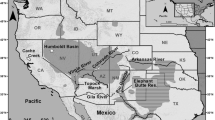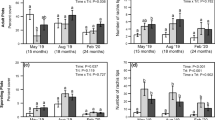Abstract
Mimosa pigra L. is one of the most troublesome weeds in northern Australia, and is the target of a large biological control program, with 14 agents released to date. This paper describes surveys conducted between 1997 and 2004, for eight of these biological control agents. Surveys assessed the establishment of key agents. Both distribution and abundance of the most damaging agent, the stem-borer Carmenta mimosa Eichlin and Passoa (Lep.: Sesiidae), increased during the eight year period and the moth is now present in all catchments with major M. pigra infestations. The tip-borer, Neurostrota gunniella Busck (Lep.: Gracillariidae) is present in all M. pigra infestations, attacking 94% of tips. The leaf and flower-feeder, Coelocephalapion pigrae Kissinger (Col., Curculionidae) is widespread and its abundance is stable. Neither Acanthoscelides puniceus Johnson (Col., Bruchidae) nor Chlamisus mimosae Karren (Col., Chrysomelidae) were widespread or abundant when surveys commenced and populations declined during the survey period. The nocturnal beetle Malacorhinus irregularis Jacoby (Col., Chrysomelidae) was not found during these surveys, but later searches using different methods found it at three sites. Six other agents appeared not to have established, or are present at densities too low to be detected. How the results of these surveys affect management of M. pigra, and projections for future impacts against this weed are discussed. Using survey results and published literature we concluded that (1) seed and flower feeders must be capable of surviving periods of low food availability; (2) some climate matching may be beneficial before fungal biocontrol agents are released and (3) even in well studied systems such as M. pigra, the failure of an agent to establish cannot always be explained.
Similar content being viewed by others
References
Baars JR, Heystek F (2003) Geographical range and impacts of five biocontrol agents established on Lantana camara in South Africa. Biocontrol 48:743–759
Barratt J, Douglas M, Paynter Q, Ashley M (2004) Examining the impacts of control over time on the seed bank of Mimosa pigra on Top End floodplains. In: Julien M, Flanagan G, Heard T, Hennecke B, Paynter Q, Wilson C (eds) Research and management of Mimosa pigra. CSIRO Entomology, Canberra, Australia, pp 102–105
Braithwaite RW, Lonsdale WM, Estbergs JA (1989) Alien vegetation and native biota in tropical Australia: the spread and impact of Mimosa pigra. Biol Conserv 48:189–210
Broughton S (1998) The distribution of lantana beetles (Coleoptera: Chrysomelidae: Hispine) in Queensland. Aust Entomol 25:39–44
Buckley Y, Rees M, Paynter Q, Lonsdale M (2004) Modelling integrated weed management of an invasive shrub in tropical Australia, Mimosa pigra. J Appl Ecol 41:547–560
Davis DR, Kassulke RC, Harley KLS, Gillett JD (1991) Systematic, morphology, biology, and host specificity of Neurostrota gunniella (Busk) (Lepidoptera: Gracillariidae), an agent for the biological control of Mimosa pigra L. Proc Entomol Soc Wash 93:16–44
Dhileepan K (2002) Evaluating the effectiveness of weed biocontrol at the local scale. In: Spafford Jacob H, Briese DT (eds) Improving the selection, testing and evaluation of weed biological control agents. CRC for Australian Weed Management, Adelaide, Australia, pp 51–60
Downey PO, Holtkamp RH, Ireson JE, Kwong RM, Swirepik AE (2007) A review of the Chrysanthemoides monilifera biological control program in Australia:1987–2005. Plant Prot Q 22:24–32
Forno IW (1992) Biological control of Mimosa pigra: research undertaken and prospects for effective control. In: Harley KLS (eds) A guide to the management of Mimosa pigra. CSIRO, Canberra, Australia, pp 38–42
Forno IW, Kassulke RC, Day MD (1991) Life cycle and host testing procedures for Carmenta mimosa Eichlin and Passoa (Lepidoptera: Sesiidae), a biological control agent for Mimosa pigra L. (Mimosaceae) in Australia. Biol Control 1:309–315
Forno IW, Heard TA, Day MD (1994) Host specificity and aspects of the biology of Coelocephalapion aculeatum (Coleoptera: Apionidae), a potential biological control agent of Mimosa pigra (Mimosaceae). Biol Control 23:147–153
Grace BS (2005) Do predators affect the survival of Macaria pallidata larvae? Implications for biological control of Mimosa pigra in the NT. NT Nat 18:8–13
Heard TA, Forno WI (1996) Host selection and host range of the flower-feeding weevil, Coelocephalapion pigrae, a potential biological control agent of Mimosa pigra. Biol Control 6:83–95
Heard TA, Segura R (2004) Agents for biological control of Mimosa pigra in Australia: review and future prospects. In: Julien M, Flanagan G, Heard T, Hennecke B, Paynter Q, Wilson C (eds) Research and management of Mimosa pigra. CSIRO Entomology, Canberra, Australia, pp 126–140
Heard TA, Segura R, Martinez M, Forno IW (1997) Biology and host range of the green-seed weevil, Sibinia fastigiata, for biological control of Mimosa pigra. Biocontrol Sci Technol 7:631–644
Heard TA, Burcher JA, Forno IW (1999) Chalcodermus serripes (Coleoptera: Curculionidae) for Biological Control of Mimosa pigra: Host relations and life cycle. Biol Control 15:1–9
Heard TA, Paynter Q, Chan R, Mira A (2005) Malacorhinus irregularis for biological control of Mimosa pigra: host specificity, life cycle and establishment in Australia. Biol Control 32:252–262
Hennecke BR (2004) The prospect of biological control of Mimosa pigra with fungal pathogens in Australia. In: Julien M, Flanagan G, Heard T, Hennecke B, Paynter Q, Wilson C (eds) Research and management of Mimosa pigra. CSIRO Entomology, Canberra, Australia, pp 117–121
Hoffmann JH, Moran VC (1998) The population dynamics of an introduced tree, Sesbania punicea, in South Africa, in response to long-term damage caused by different combinations of three species of biological control agents. Ocecologia 114:343–348
Kassulke RC, Harley KLS, Maynard GV (1990) Host specificity of Acanthoscelides quadridentatus and A. puniceus [Col: Bruchidae] for biological control of Mimosa pigra with preliminary data on their biology. Entomophaga 35:85–96
Lonsdale WM (1988) Litterfall in an Australian population of Mimosa pigra, an invasive tropical shrub. J Trop Ecol 4:381–392
Lonsdale WM (1992) The biology of Mimosa pigra. In: Harley KLS (ed) A guide to the management of Mimosa pigra. CSIRO, Canberra, Australia, pp 8–32
Lonsdale WM, Farrell GS (1998) Testing the effects on Mimosa pigra of a biological control agent Neurostrota gunniella (Lepidoptera: Gracillariidae), plant competition and fungi under field conditions. Biocontrol Sci Technol 8:484–500
Lonsdale WM, Segura R (1987) A demographic study of native and introduced populations of Mimosa pigra. In: Lemerle D, Leys AR (eds) Proceedings of the thirteenth Australian Weeds Conference. Weeds Society of New South Wales, Wagga, Wagga, Australia, pp 163–166
Lonsdale WM, Harley KLS, Gillett JD (1988) Seed bank dynamics in Mimosa pigra, an invasive tropical shrub. J Appl Ecol 25:963–976
Lonsdale WM, Miller IL, Forno IW (1995) Mimosa pigra L. In: Groves RH, Sheppard RCH, Richardson RG (eds) The biology of Australian weeds. RG and FJ Richardson Publishers, Melbourne, Australia, pp 169–188
Micinski S, Waltman WF (2005) Range expansion of Rhinocyllus conicus Froelich on musk thistle in Northwest Louisiana. Southwest Entomol 30:23–27
Nordblom TL, Smyth MJ, Swirepik A, Sheppard AW, Breise DT (2002) Spatial economics of biological control: investing in new releases of insects for earlier limitation of Paterson’s curse in Australia. Agr Econ 27:403–424
Ostermeyer N (2000) Population density and distribution of the biological control agent Carmenta mimosa on Mimosa pigra in the Adelaide and Finniss River catchments of the Northern Territory. Plant Prot Q 15:46–50
Ostermeyer N, Grace B, Paskins M, McIntyre V, Routley B (2004) Biological control in the Top End: getting communities involved. In: Sindel BM, Johnson SB (eds) Proceedings of the fourteenth Australian Weeds Conference. Weeds Society of New South Wales, Sydney, Australia, pp␣337–340
Paynter Q (2004) Evaluating Mimosa pigra biological control in Australia. In: Julien M, Flanagan G, Heard T, Hennecke B, Paynter Q, Wilson C (eds) Research and management of Mimosa pigra. CSIRO Entomology, Canberra, Australia, pp 141–148
Paynter Q (2005) Evaluating the impact of a biological control agent Carmenta mimosa on the woody wetland weed Mimosa pigra in Australia. J Appl Ecol 42:1054–1062
Paynter Q (2006) Evaluating the impact of biological control against Mimosa pigra in Australia: comparing litterfall before and after the introduction of biological control agents. Biol Control 38:166–173
Paynter Q, Flanagan GJ (2002) Integrated management of Mimosa pigra. In: Spafford Jacob H, Dodd J, Moore JH (eds) Proceedings of the thirteenth Australian Weeds Conference. Plant Protection Society of WA, Perth, Australia, pp 165–168
Paynter Q, Flanagan GJ (2004) Integrating herbicides and mechanical control treatments with fire and biological control to manage an invasive wetland shrub, Mimosa pigra. J Appl Ecol 41:615–629
Paynter Q, Hennecke B (2001) Competition between two biological control agents, Neurostrota gunniella and Phloeospora mimosae-pigrae, and their impact on the invasive tropical shrub Mimosa pigra. Biocontrol Sci Technol 11:575–582
Routley BM, Wirf LA (2006) Advancements in biocontrol of Mimosa pigra in the Northern Territory. In: Preston C, Watts JH, Crossman ND (eds) Proceedings of the fifteenth Australian Weeds Conference. Weed Management Society of South Australia, Adelaide, Australia, pp␣561–564
Sheppard AW (2002) Prioritising agents based on predicted efficacy: beyond the lottery approach. In: Spafford Jacob H, Briese DT (eds) Improving the selection, testing and evaluation of weed biological control agents. CRC for Australian Weed Management, Adelaide, Australia, pp 11–21
Sheppard AW, Hill R, DeClerck-Floate RA, McClay A, Olckers T, Quimby PC, Zimmermann HG (2003) A global review of risk-benefit-cost analysis for the introduction of classical biological control agents against weeds: a crisis in the making? Biocontrol News Info 24:91N–108N
Smith CS, Wilson CG (1995) Close to the edge: microhabitat selection by Neurostrota gunniella (Busk) (Lepidoptera: Gracillariidae), a biological control agent for Mimosa pigra L. in Australia. J Aust Entomol Soc 34:177–180
Steinbauer MJ, Edwards PB, Hoskins M, Schatz T, Forno W (2000) Seasonal abundance of insect biocontrol agents of Mimosa pigra in the Northern Territory. Aust J Entomol 39:328–335
Swirepik AE, Smyth MJ (2002) Evaluating biocontrol at the regional scale. In: Spafford Jacob H, Briese DT (eds) Improving the selection, testing and evaluation of weed biological control agents. CRC for Australian Weed Management, Adelaide, Australia, pp 61–67
Wilson CG, Flanagan GJ (1990) Establishment and spread of Neurostrota gunniella on Mimosa pigra in the Northern Territory. In: Swarbrick JT (ed) Proceedings of the ninth Australian Weeds Conference. Australian Weed Science Society, pp 505–507
Wilson CG, Flanagan GJ (1991) Establishment of Acanthoscelides quadridentatus (Schaeffer) and A.␣puniceus Johnson (Coleoptera: Bruchidae) on Mimosa pigra in northern Australia. J Aust Entomol Soc 30:279–280
Wilson CG, Forno IW (1995) The biological control program against Mimosa pigra in Australia’s Northern Territory. In: Proceedings of the eight International Symposium on Biological Control of Weeds. Christchurch, New Zealand, pp 75–80
Zalucki M, van Klinken RD (2006) Predicting population dynamics and abundance of introduced biological agents: science or gazing into crystal balls. Aust J Entomol 45:331–344
Acknowledgements
These surveys were initiated by Grant Flanagan. We especially thank Merrilyn Paskins for her work in organising the surveys. NT government and CSIRO staff, in particular Bert Lukitsch, Bruce Hitchins, Magen Geyer, Matthew Hoschke, Megan Hoskins, Nadine Graham, Suzanne Gall and Tim Schatz all helped conduct the surveys. Thanks to Laura Wirf, Jane Barratt, Graham Brown, Bron Routley, Tim Heard and an anonymous reviewer for helpful comments on this manuscript. This work was supported by the Natural Heritage Trust and the Northern Territory government.
Author information
Authors and Affiliations
Corresponding author
Rights and permissions
About this article
Cite this article
Ostermeyer, N., Grace, B.S. Establishment, distribution and abundance of Mimosa pigra biological control agents in northern Australia: implications for biological control. BioControl 52, 703–720 (2007). https://doi.org/10.1007/s10526-006-9054-0
Received:
Accepted:
Published:
Issue Date:
DOI: https://doi.org/10.1007/s10526-006-9054-0




